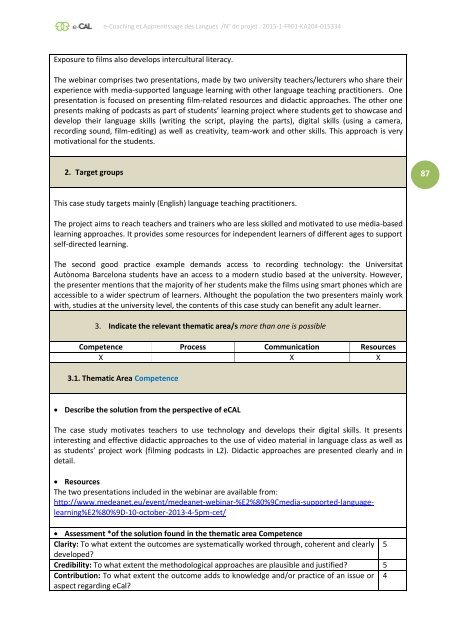e-CAL - e-Coaching et Apprentissage des Langues
The ERASMUS+ project e-CAL presents the result of an analysis of support methods in the case of language learning using web-based Open Educational Resources (OER).
The ERASMUS+ project e-CAL presents the result of an analysis of support methods in the case of language learning using web-based Open Educational Resources (OER).
You also want an ePaper? Increase the reach of your titles
YUMPU automatically turns print PDFs into web optimized ePapers that Google loves.
e-<strong>Coaching</strong> <strong>et</strong> <strong>Apprentissage</strong> <strong>des</strong> <strong>Langues</strong> /N° de proj<strong>et</strong> : 2015-1-FR01-KA204-015334<br />
Exposure to films also develops intercultural literacy.<br />
The webinar comprises two presentations, made by two university teachers/lecturers who share their<br />
experience with media-supported language learning with other language teaching practitioners. One<br />
presentation is focused on presenting film-related resources and didactic approaches. The other one<br />
presents making of podcasts as part of students’ learning project where students g<strong>et</strong> to showcase and<br />
develop their language skills (writing the script, playing the parts), digital skills (using a camera,<br />
recording sound, film-editing) as well as creativity, team-work and other skills. This approach is very<br />
motivational for the students.<br />
2. Targ<strong>et</strong> groups<br />
87<br />
This case study targ<strong>et</strong>s mainly (English) language teaching practitioners.<br />
The project aims to reach teachers and trainers who are less skilled and motivated to use media-based<br />
learning approaches. It provi<strong>des</strong> some resources for independent learners of different ages to support<br />
self-directed learning.<br />
The second good practice example demands access to recording technology: the Universitat<br />
Autònoma Barcelona students have an access to a modern studio based at the university. However,<br />
the presenter mentions that the majority of her students make the films using smart phones which are<br />
accessible to a wider spectrum of learners. Althought the population the two presenters mainly work<br />
with, studies at the university level, the contents of this case study can benefit any adult learner.<br />
3. Indicate the relevant thematic area/s more than one is possible<br />
Comp<strong>et</strong>ence Process Communication Resources<br />
X X X<br />
3.1. Thematic Area Comp<strong>et</strong>ence<br />
Describe the solution from the perspective of e<strong>CAL</strong><br />
The case study motivates teachers to use technology and develops their digital skills. It presents<br />
interesting and effective didactic approaches to the use of video material in language class as well as<br />
as students’ project work (filming podcasts in L2). Didactic approaches are presented clearly and in<br />
d<strong>et</strong>ail.<br />
Resources<br />
The two presentations included in the webinar are available from:<br />
http://www.medean<strong>et</strong>.eu/event/medean<strong>et</strong>-webinar-%E2%80%9Cmedia-supported-languagelearning%E2%80%9D-10-october-2013-4-5pm-c<strong>et</strong>/<br />
Assessment *of the solution found in the thematic area Comp<strong>et</strong>ence<br />
Clarity: To what extent the outcomes are systematically worked through, coherent and clearly 5<br />
developed?<br />
Credibility: To what extent the m<strong>et</strong>hodological approaches are plausible and justified? 5<br />
Contribution: To what extent the outcome adds to knowledge and/or practice of an issue or 4<br />
aspect regarding eCal?


